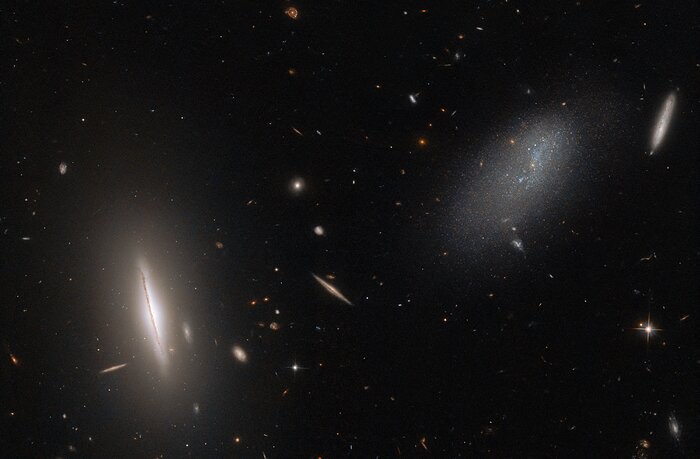The deepest image ever of the distant universe from Hubble Space Telescope's eXtreme Deep Field (XDF) may show approximately 170 billion galaxies visible in the cosmos. But observations and theoretical simulations reveal there are considerably dim galaxies that are yet to find, which means there could be about 6 to 20 trillion out there.
Now, a newly released magnificent image by Hubble shows two neighboring galaxies, LEDA 48062 and UGC 8603, located in the constellation of Canes Venatici.

This new image from Hubble features the galaxy LEDA 48062 in the constellation Perseus. LEDA 48062 is the faint, amorphous galaxy on the right, and it is accompanied by the disc-like galaxy UGC 8603 on the left.
Every Known Nearby Galaxy Campaign
The NASA/ESA Hubble Space Telescope obtained the cosmic scene, featuring the dim, sparse, amorphous LEDA 48062 galaxy on the right side of the picture. The galaxy is joined on the left by a more clearly defined neighbor, the massive, disc-like lenticular galaxy UGC 8603.
The backdrop is generally dark and empty, with a few distant galaxies sprinkled throughout, of the Hubble image supplied by the European Space Agency (ESA) with a few foreground stars can also be seen, according to Devdiscourse.
LEDA 48062 is located in the constellation Perseus, which is only around 30 million light-years from the Milky Way. It was part of the Every Known Nearby Galaxy campaign, which aimed to examine every known galaxy within 10 megaparsecs (about 33 million light-years) of the Milky Way.
The campaign may help astronomers learn more about Milky Way's galactic neighbors and map out the local structure of the universe by knowing what type of stars are in various galaxies.
What Are Those Four Sharp Points in Hubble Images?
The diffraction spikes seen in the Hubble images are created when starlight spreads around or diffracts the support structures inside, which reflects telescopes like the Hubble, according to SciTech Daily.
The four spikes are caused by the four narrow vanes that support the space telescope's secondary mirror and are only visible for bright objects like stars when there is a lot of light focused in one location. Diffraction spikes are not apparent in darker, more spread-out objects, such as the galaxies LEDA 48062 and UGC 8603.
Since its debut in 1990, the Hubble Space Telescope has been investigating the universe. Over the course of its 32 years of operation, the telescope has made over 1.5 million observations, revolutionizing our understanding of the universe.
READ ALSO: Sparkling Star Cluster NGC 2660 Seen by Hubble Space Telescope
The Nearest Galaxies
According to NASA, it would take an estimated 749,000,000 years to travel the distance of 25,000 light-years at Voyager's speed to reach the closest galaxy to the Milky Way, which is the Canis Major Dwarf. But it will still take about 25,000 years to travel it at the speed of light.
Before the discovery of Canis Major Dwarf in 2003, scientists thought that the Large and Small Magellanic clouds were the closest galaxies to Milky Way. But it was first overthrown in 1994 when they discovered the Sagittarius Dwarf Elliptical Galaxy (SagDEG).
The Large Magellanic Cloud (LMC) and the Small Magellanic Cloud (SMC) are conspicuous objects visible from the southern hemisphere sky. It was Ferdinand Magellan who brought them to today's knowledge while on his voyage around the world in 1519. The LMC is approximately 179,000 light-years away, while the SMC is further out at 210,000 light-years.
The SagDEG was discovered in 1994 and is about 70,000 light-years away, which is closer to Milky Way. But then in 2003, scientists discovered Canis Major Dwarf located just 25,000 light-years from the Sun, and 42,000 light-years from the Milky Way's center.
RELATED ARTICLE: Hubble Space Telescope Spots Long-Armed Galaxy 450 Million Light-Years Away in Great Detail
Check out more news and information on Space in Science Times.














